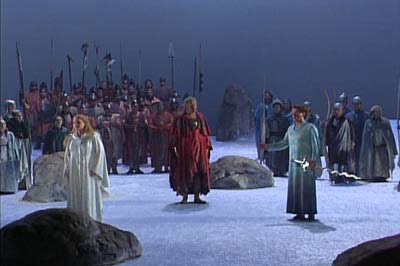Two Bayreuth Lohengrins offer very different takes on Wagner's mythic opera.
by Paul J. Pelkonen
by Paul J. Pelkonen
 |
| Cheryl Studer, Manfred Schenk and Paul Frey in Lohengrin. |
The Act III Grail Narration from the Götz Friedrich production of Lohengrin.
 |
| Lead poisoning: Elizabeth Connell, Karan Armstrong, Peter Hofmann and Bernd Weikl in Lohengrin. Image © Unitel/Universal Classics. |
Unfortunately the cast does not live up to the production. Peter Hoffmann was the Johnny Bravo of would-be heldentenors. Tall. Blond. Studly. Looked great with his shirt off in the 1976 Die Walküre. But here in 1981, he was already on the down-slope, his voice pinched and reedy in the upper register needed for this role. But boy, he sure looks good in that armor!
Karan Armstrong and a young Elizabeth Connell are an effective, sisterly Elsa and Ortrud, two sides of the same coin. Leif Roar lives up to his name as Telramund. The choral work, under the direction of Wolfgang Pitz, is superb, as one would expect at Bayreuth.
Lohengrin's laser-driven entrance in Act I of the Herzog production at Bayreuth.
The singers are pretty solid across the board. Paul Frey is almost as good-looking as Peter Hoffmann, a dark, handsome Swan Knight with a better tenor. Cheryl Studer hits her brief peak as Elsa. Manfred Schenk, an underrated bass, is a phenomenal King Heinrich. As the Telramunds, Wlaschiha and Schnaut are both snarling and over the top. Schnaut actually does her Act II invocation to the pagan gods while standing shin-deep in an onstage water-tank. All the vocal principals are a considerable upgrade over the earlier production.
The earlier performance (Friedrich) is better, with more fire coming out of the pit under Woldemar Nelsson. In the Herzog, Peter Schneider conducts. He was brought in to replace another conductor at the last minute, and does not sound as confident or driven. Schneider maintains a solid, foursquare beat, he knows this opera back-to-front, but he does not compete with the three big K's (Kempe, Kubelik, and Keilberth.)
A final note: both of these productions were once available on CD during the classical boom of the '90s, the Friedrich/Hoffman/Armstrong from CBS Masterworks, the '90 from Philips. It should say something about their general quality that while the DVDs have been re-issued, the audio recordings remain deleted.
All video content © Deutsche Grammophon/Universal Music Group. Reposted from YouTube. Used for promotional purpose only.




